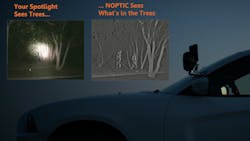Content Provided by NOPTIC
When the sun goes down for the day, tasks that would normally be easy to complete can become challenging or even trecherous. As an officer you can’t just pack it up and head inside when conditions are less than ideal. Human beings have always looked for ways to see better at night. Thermal Imaging Cameras (TIC) do not “see” visible light but instead heat signatures. Since they arent effected by visible light they are an ideal way to gain valuable information about your surroundings when you can’t see much with your eyes. Even during the day suspects can attempted to camoflauge themselves by hiding in bushes. Hiding your heat signature is nearly impossible.
Those of you who recently served in the military may already be familiar with the benefits of TICs. Thermal was initially pioneered by defense contractors who were urged by their clients to develop ways for our soliders to see in low visibily situations. The armed forces have used this technology to give our soldiers an advantage on the battlefield for many years. As the technology has matured and more industries have adopted it, the costs and physical size of the devices have shrunk to a point where many police departments are integrating TICs into their patrol operations.
The use cases for these cameras span from the extreme to mundane. It is easy to think of situations where it would be advantageous to see at night, fleeing suspects and missing persons probably jump right to your mind. The TIC is an ideal partner in these types of searches. Other industries use thermal cameras to check on home heating efficency as well as for finding hot spots in large animals like horses. In the automotive industry they are used to detect pedestrians and large animals and alert drivers to their presence well before they come into the car’s headlights.
When law enforement agencies intitially started using handheld TICs they often purchased one to keep at the station or in a supervisor’s vehicle. If the events of the night called for it, someone would go locate it while the rest of the team set up a perimeter. Smaller departments would often borrow these cameras from their local fire department on a case by case basis. Agencies with the budget could also purchase roof mounted Pan Tilt Zoom TICs which are especially good at spotting people from thousands of feet away. Those lucky enough to use these cameras saw right away how they could revolutionize night time operations for police.
Some Limitations
By its very nature TICs have some technical limitations. They cannot see through glass or into water because both surfaces block the heat that the camera picks up. Heat does reflect off glass so it can be used to see around corners. As long as some portion of a person is still above the water they can easily be spotted since their heat signature will stand out against the relatively colder water.
Enter NOPTIC
The Nighttime OPtical Thermal Imaging Camera or NOPTIC was born in 2005. It came about when a pair of automotive engineers repurposed a TIC that was originally developed for use in luxury cars. These engineers mounted the camera to the back of the ubiquitus Unity A-pillar spotlight. Their idea was that pairing a spotlight with a TIC would offer officers a new tool to locate people at night. Since it was powered separately from the light, the camera could run whenever the car was on. Its ability to operate in total darkness meant that for the first time ever, cops could scan their immediate area with their lights completely blacked out and view and record the thermal video footage on their MDTs. Officers have been using the Unity spotlights for decades so they are already adept and getting them in position very quickly. This mounting arrangement wouldn’t force anyone to have to learn how to use a remote control or drill addition holes in their car during the upfitting process.
Picture This
You get a call about a domestic disturbance on the outskirts of your town. As you drive down the long driveway you can just make out a flash as the front door opens and shuts, one of the involved parties saw your lights and decided to take off before you had a chance to contact them. With a thermal camera like NOPTIC you could black out as you pull onto their driveway and position yourself in front of their house without alerted anyone to your presence. If the suspect happened to glance out the window and see you, if they took off into the forrest they would glow white hot and depending on ambient tempratures leave thermal footprints making it much easier to send the K9 off on the correct track. With the Visual Intellience you gain using NOPTIC, how much more safely and effectively could you do your job?
In the current climate for policing a thermal camera can be a great tool to increase officer safety. It offers superior situational awareness at night since it can be panned around a house or vehicle to proactively check for anything out of the ordinary. Like most technology it is easy to go without until you have experienced it firsthand and seen exactly what you are missing. Once you are aware of all that is out there it is very hard to patrol without it.
Click here to see the technology in action. These side by side comparison videos show what you see with your eyes and what you could be seeing if you had NOPTIC on your car.
#searchwithstealth



